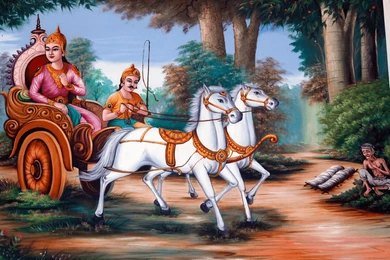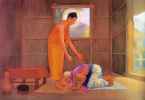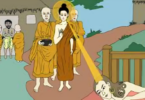Prince Siddhartha, known later as the Buddha, had a remarkable education that shaped his path to enlightenment. His early life in a royal palace equipped him with knowledge about the world, yet he sought deeper truths beyond material wealth. This quest led him to not only challenge traditional thinking but also to establish profound teachings that continue to influence millions today.
Foundations of Enlightenment and Spiritual Leadership

As Siddhartha ventured beyond the comforts of his life, he encountered suffering, prompting him to seek answers about existence. This journey was vital in forming his views on life and spirituality. His experiences ultimately laid the groundwork for Buddhism, a path that has transformed countless lives.
Understanding the education of Prince Siddhartha highlights the importance of questioning and seeking knowledge. His legacy endures as a reminder that true understanding often lies outside material possessions and societal expectations.
Key Takeaways
- Prince Siddhartha’s royal upbringing provided a foundation for his search for deeper truths.
- His experiences with suffering led to the development of his significant teachings.
- The impact of Siddhartha’s journey continues to resonate in the teachings of Buddhism today.
Early Life of Prince Siddhartha

Prince Siddhartha, later known as the Buddha, was born into a royal family. His early life set the foundation for his future teachings and enlightenment.
Birth and Royal Lineage
Siddhartha was born in Lumbini, which is now part of Nepal, around the 6th century BCE. He was the son of King Suddhodana and Queen Maya. The family belonged to the Shakya clan.
His mother died shortly after giving birth. Siddhartha was raised by his aunt, Pajapati. As a prince, he received the finest care and was expected to lead the kingdom one day.
Prophecy and Protected Upbringing
Before Siddhartha’s birth, a sage predicted he would become either a great king or a holy man. To ensure he would choose kingship, his father kept him away from anything that might lead to spiritual thoughts.
He was sheltered in a luxurious palace filled with pleasures. The king provided him with all comforts, hoping to prevent him from seeing suffering. This overprotection shaped Siddhartha’s early experiences.
Education and Training
As a child, Siddhartha received a comprehensive education. He learned about arts, music, and literature, which were essential for a royal.
In addition to academics, he was trained in martial arts and ethics. Siddhartha was taught to be wise and strong, preparing him to rule effectively. His learning was extensive, yet it eventually led him to question the nature of happiness and suffering in life.
Path to Enlightenment
The journey to enlightenment for Prince Siddhartha was marked by significant events and deep realizations. Each experience brought him closer to understanding the nature of suffering and the path to true liberation.
Encounters with Suffering
During his early life, Siddhartha lived in luxury, shielded from the outside world. However, one day he ventured out and encountered four sights that would change his life: an old man, a sick person, a dead body, and an ascetic.
These encounters revealed the harsh realities of life. Siddhartha realized that suffering is an unavoidable part of existence. The experience deeply affected him and sparked a quest for truth. He wanted to find a way to overcome suffering and achieve lasting peace.
Renunciation of the Throne
After his shocking discoveries about life, Siddhartha made a significant decision. He chose to renounce his royal title and material wealth. This act signified his commitment to seek a deeper understanding of life and its challenges.
He left his palace, his family, and everything he once held dear. This moment marked the beginning of his quest for spiritual truth. Siddhartha was determined to find a solution to the suffering he had witnessed.
Ascetic Practices
Siddhartha explored various ascetic practices in his search for enlightenment. He tried extreme fasting and rigorous physical hardships, believing that self-denial would lead to spiritual insight.
For years, he lived in great discomfort, thinking that suffering would help him reach his goals. However, he eventually realized that these practices did not bring him closer to understanding or peace. This insight prompted a shift in his approach to enlightenment.
Meditation and Insight
Ultimately, Siddhartha turned to meditation as a key method for achieving enlightenment. He sat under the Bodhi tree, vowing not to rise until he found the truth.
Through deep concentration and mindfulness, he began to see the nature of reality. In this state, he gained profound insights about suffering, the self, and the impermanence of life. This moment led to his awakening as the Buddha, fully understanding the path toward liberation from suffering.
Teachings of Buddha

Buddha’s teachings focus on understanding suffering, ethical behaviour, and the path to enlightenment. His insights guide followers in their journey toward spiritual awakening.
Four Noble Truths
The Four Noble Truths are central to Buddhist beliefs. They outline the nature of suffering and the path to overcoming it.
- Dukkha: Life is full of suffering, which includes pain, dissatisfaction, and unhappiness.
- Samudaya: Suffering arises from attachment and desire, known as
tanha. - Nirodha: It is possible to end suffering by letting go of desire.
- Magga: The way to end suffering is through the Noble Eightfold Path.
These truths help individuals understand the reality of life and encourage them to seek a deeper understanding of their experiences.
Noble Eightfold Path
The Noble Eightfold Path is a practical guide for ethical and mental development. It consists of eight interconnected aspects that promote moral living and spiritual growth.
- Right Understanding: Understanding the nature of reality and the path of transformation.
- Right Intent: Committing to a life of non-harm and compassion.
- Right Speech: Speaking truthfully and kindly.
- Right Action: Behaving ethically in one’s actions.
- Right Livelihood: Earning a living in a way that does not harm others.
- Right Effort: Cultivating positive states of mind.
- Right Mindfulness: Knowing one’s thoughts, feelings, and surroundings.
- Right Concentration: Practicing meditation and focused awareness.
Following this path helps practitioners develop wisdom, ethical conduct, and mental discipline.
Morality, Concentration, and Wisdom
Buddha emphasized three key areas: morality, concentration, and wisdom. These principles form the foundation of a devoted Buddhist life.
- Morality (Sīla): Ethical conduct involves not harming living beings and practising kindness.
- Concentration (Samādhi): This refers to focused meditation. Practitioners develop deeper awareness and peace.
- Wisdom (Paññā): Wisdom comes from understanding the nature of reality and oneself.
These areas are interconnected and essential for achieving enlightenment and liberation from suffering.
Influence and Legacy

Prince Siddhartha, who later became known as the Buddha, had a profound influence on the world through his teachings and the development of Buddhism. His legacy remains significant in different areas, including the expansion of Buddhism itself, notable Buddhist councils, and its cultural and historical effects.
Expansion of Buddhism
After Siddhartha’s passing, Buddhism spread widely throughout Asia. Missionaries played a crucial role in this expansion.
- Key Regions:
- India
- Southeast Asia
- Central Asia
- East Asia
Buddhism adapted to various cultures, resulting in diverse schools of thought. Such schools included Mahayana, Theravada, and Vajrayana. Each contributed unique concepts and practices, enriching Buddhist teachings.
Buddhist Councils
Buddhist councils were essential for preserving and organizing sacred texts and teachings. The first council took place shortly after Siddhartha’s death. Key contributions include:
- The Pali Canon: This text is fundamental for Theravada Buddhism.
- Later Councils: These included debates and discussions that shaped Buddhist thought.
The councils ensured that the teachings remained intact and relevant for future generations. They played a vital role in addressing disagreements and establishing a unified path for Buddhists.
Cultural and Historical Impact
The influence of Siddhartha and his teachings reached far beyond religion. Buddhism shaped art, literature, and philosophy in various regions.
- Art: Buddhist art influenced sculptures, paintings, and architecture.
- Literature: Many texts explored themes of ethics and morality.
- Philosophy: Concepts of mindfulness and compassion became integral to many cultures.
Buddhism also impacted social structures, encouraging values like non-violence and compassion. It fostered a sense of community among followers and contributed to peace movements throughout history.
Frequently Asked Questions

This section answers common questions about Prince Siddhartha’s life, education, and the teachings he shared after his enlightenment. The focus is on key events and concepts related to his journey.
What is the story of Prince Siddhartha’s early life?
Prince Siddhartha was born into a royal family. His father, King Suddhodana, ruled the Shakya clan in present-day Nepal. Siddhartha lived a sheltered life, surrounded by luxury until he began to question the meaning of life beyond his palace walls.
At what location was Prince Siddhartha born?
Prince Siddhartha was born in Lumbini, which is now part of Nepal. Today, Lumbini is a significant pilgrimage site for Buddhists from all over the world. The site is marked by a sacred tree and a pond, where his mother gave birth to him.
At what age was Siddhartha sent for his education?
Siddhartha was sent for his education at a young age, around the age of 16. His father arranged for him to learn from the best teachers in the kingdom. He studied various subjects, including philosophy, literature, and martial arts.
How did Prince Siddhartha’s journey lead him to become the Buddha?
Siddhartha’s journey began when he ventured outside the palace and encountered suffering for the first time. He saw an old man, a sick person, and a dead body, which deeply troubled him. This prompted him to leave his royal life in search of enlightenment, ultimately leading him to become the Buddha.
What teachings did Siddhartha impart after his enlightenment?
After attaining enlightenment, Siddhartha, known as the Buddha, shared his insights on suffering and the path to liberation. He taught the Four Noble Truths, which explain the nature of suffering and the way to overcome it. His teachings emphasized the importance of compassion and mindfulness.
What philosophical views did the Buddha express regarding education?
The Buddha believed education was essential for personal development. He encouraged critical thinking and self-reflection. His teachings highlighted that learning should lead to wisdom, understanding, and compassionate action in the world.

Prince Siddhartha
Prince Siddhartha was born in Lumbini Sal Park at Kapilvasthupura. His parents were King Suddhodana and Queen Mahamaya. After the demise of Queen Mahamaya, her sister Queen Prajapathi Gothami was taking care of Prince Siddhartha.
King Suddhodana sent Prince Siddhartha to Sarvamiththa, for his education. Sarvamiththa was a well-known teacher. He taught the children from noble families such as kings, ministers and healthy people.✓
The Prince learnt languages, reading, writing, history, mathematics, sanskruth etc. He also took part in sports like sword art, archery, horse riding and many more. He was a very bright and obedient student. He was popular and loved by all. He was never Lazy. He learnt everything faster than others. The prince was kind to animals and never hurt them.
He always respected his teacher and learnt and practised everything that was taught. He never hurt the feelings of the teacher or anyone else. He was ahead of others in learning and sports.
Finally, Sarvamitha took him to the king and said “I have taught the prince everything that I know and he has learnt them all.”
Activity
- Who was the teacher of Prince Siddhartha?
2. What did the prince learn from his teacher?
3. What made Prince Siddhartha special than others?
Read About: Sumudu’s Birthday







Leave a Comment